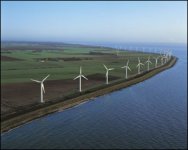Netlist said:
Can you provide links to these claims? I'd love to read more.
/Hugo 🙂
sorry, I don't have anything that I can quote right off my head. Will keep an eye out for it.
tlf9999 said:
sorry, I don't have anything that I can quote right off my head. Will keep an eye out for it.
While you are at it, see what you can find on the effect of tall buildings on wind flow and hydro-electric/pump storage on fish.
rfbrw said:
While you are at it, see what you can find on the effect of tall buildings on wind flow and hydro-electric/pump storage on fish.
You should see how many baitfish get trapped in our intake screens!
ghudnub said:
You should see how many baitfish get trapped in our intake screens!
So in a nutshell, such things happen and one just lives with it. Much as I thought.
ghudnub said:
It would take ~740 of those giant 3MW windmills to equal the power output of our plant.
Thanks, that gives a rough idea. And, like all technologies, I'm sure these mills will be more efficient compared to some decades ago. Which brings us back to the original thread starter's post.
Suppose in ten years we could again double the efficiency, only half of them would do the job.
For the record, I am opposed to nuclear plants part because I'm aware of the impact of a possible disaster, part because I tend to sympathize more with people searching for environmental friendly energy. If research really proves windmills are not what I think they are I'll gladly review my opinions. Like all things, without knowledge and hard numbers, we only talk about subjective facts.
/Hugo
The Germans have a 4.5 MW wind turbine now, so it will probably take less than 10 years but in the meantime we may have to get used to.... www.afm.dtu.dk/wind/turbines/gallery.html
Hugo, unfortunately, there are efficiency limits forced by thermodynamics. IIRC, the maximum possible efficiency is something like 60%. And even that can only be achieved if you are talking about one single windmill with nothing around it. Ignoring the perturbations in air flow from surrounding windmills (the more windmills, the less wind), as you make the vanes larger, you have to make them taller and space them further apart, reducing the number of windmills per unit area. And the area is limited...
TANSTAAFL, I'm afraid.
Really, nuclear power is quite environmentally friendly. It has other worries, but the only environmental problems are plants which are built with a deliberate disregard of safety (like the old Soviet plants). And ANY technology is dangerous if safety is ignored in the design.
TANSTAAFL, I'm afraid.
Really, nuclear power is quite environmentally friendly. It has other worries, but the only environmental problems are plants which are built with a deliberate disregard of safety (like the old Soviet plants). And ANY technology is dangerous if safety is ignored in the design.
Netlist said:For the record, I am opposed to nuclear plants part because I'm aware of the impact of a possible disaster,
anything, if not properly managed, will have an impact of a possible disaster, be it nuclear, hydro, or windmill. If your threshold is "disaster", you will not be able to support any form of technology.
Bioengineering of food sources is a new form of technology. If it is not managed, it could cause a great disaster. But, if used properly, the billions of hungry people in the world would have food. Come to think of it, a lot of the malnutrition in the world has more to do with politics than lack of food.
I may have opened a new can of worms here, but much research needs to be done yet.
I may have opened a new can of worms here, but much research needs to be done yet.
CBS240 said:Bioengineering of food sources is a new form of technology. If it is not managed, it could cause a great disaster. But, if used properly, the billions of hungry people in the world would have food. Come to think of it, a lot of the malnutrition in the world has more to do with politics than lack of food.
I may have opened a new can of worms here, but much research needs to be done yet.
The nutritional deficiencies of third world countries have precious little to do with global lack of food. IIRC, the food wasted by the first world countries every week is sufficient to feed the third world countries for an entire year. The problem is getting food and funding to the people while bypassing the leaders of said countries who are a far larger part of the problem.
AudioFreak said:getting food and funding to the people while bypassing the leaders of said countries who are a far larger part of the problem.
that, realistically, isn't an option most of the time.
Sometimes, it takes a little out-of-the-box thinking to solve some problems. A french company, for example, makes peanut butter paste that can be ate right out of the packaging. It for the most part has solved child mal-nutritional problems in areas where it is used. It beats out powdered milk.
Why? powdered milk requires clean water to mix and is hard to restore. and clean water and **** aren't exactly plentiful in poor areas. the peanut butter, on the other hand, can be stored for a long time in vaccumed plastic bags and needs no preparation before using.
Sometimes, you just got to think out of the box.
rfbrw said:The Germans have a 4.5 MW wind turbine now, so it will probably take less than 10 years but in the meantime we may have to get used to.... www.afm.dtu.dk/wind/turbines/gallery.html
Hey, that's a start. It'd only take ~450 of those to match our power output. Somebody do a photochop of 450 of those on a landscape, just to give the reader an impression of what it might look like 😉
ghudnub said:Somebody do a photochop of 450 of those on a landscape, just to give the reader an impression of what it might look like 😉
there is a name for that picture in Germany: utopia, 🙂
ghudnub said:
Hey, that's a start. It'd only take ~450 of those to match our power output. Somebody do a photochop of 450 of those on a landscape, just to give the reader an impression of what it might look like 😉
Some more perspective...1MW will typically power ~750 homes, so a few of these behemoths in a community could power a bunch of homes with zero greenhouse emissions (just like a nuke plant). Industry is who uses the bulk of the energy.
ghudnub said:
Somebody do a photochop of 450 of those on a landscape, just to give the reader an impression of what it might look like 😉
We are familiar with ugly traffic roads and have accepted them.
Honestly, I’m more fascinated by soothing windmills.
/Hugo 🙂
Attachments
I pay about $200 a month in electric bills (average, excluding the pool which is on its own meeter), and electricity costs about 7-8c/kwh, and ratches up from there. Let's say that the average for my usage is 10c/kwh. that means I use about 2,000kwh per month, or about 3kw per hour per day, every hour and every day. If you take out the nights, that is about 6kw during the day.
a 1mw turbine is good for 166 of us, assuming we have enough winds every day.
a 1mw turbine is good for 166 of us, assuming we have enough winds every day.
ghudnub said:
Hey, that's a start. It'd only take ~450 of those to match our power output. Somebody do a photochop of 450 of those on a landscape, just to give the reader an impression of what it might look like 😉
They're a lot easier on the eye than a power station, nuclear or otherwise.
rfbrw said:They're a lot easier on the eye than a power station, nuclear or otherwise.
I don't know... i always liked the look of the big vase-shaped containment towers....
A farm of wind generators is alike to the blight of telephone poles everywhere
dave
Netlist said:
We are familiar with ugly traffic roads and have accepted them.
what if that ugly traffic roads would disappear at random and take away its occupants with it from time to time? you think we will still build them?
- Status
- Not open for further replies.
- Home
- Member Areas
- The Lounge
- Very Cool

